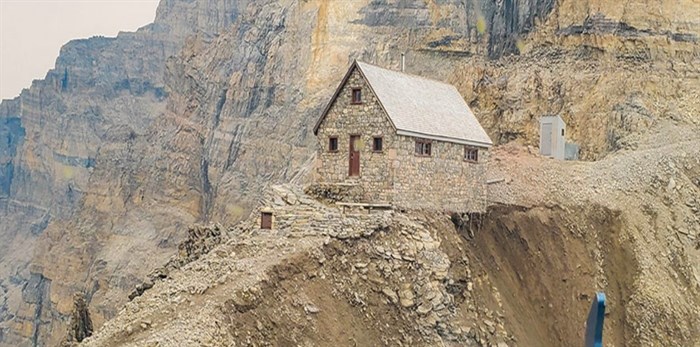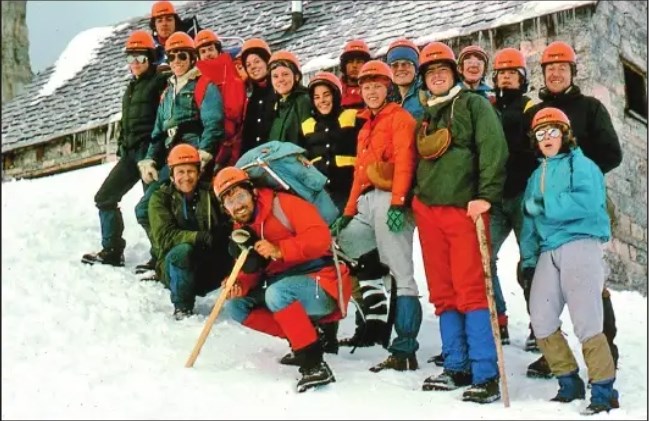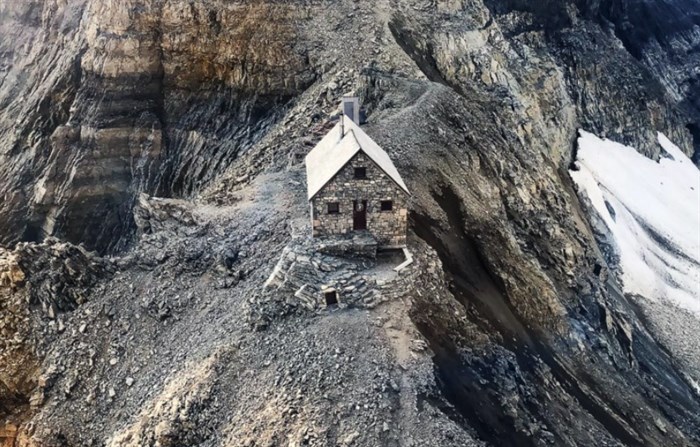
This rock cabin on the Continental Divide is set to be demolished this summer.
Image Credit: Submitted/Parks Canada
March 30, 2022 - 10:00 AM
Severe storms that washed out southern Interior highways and flooded the Lower Mainland, heat domes and forest fires are all signs of climate change.
But, on the far side of B.C., high up in a Rocky Mountain pass, the melting glaciers mean that a century-old rock cabin and national historic site that straddles the Continental Divide will be demolished this summer.
The Abbot Pass Refuge Cabin was built in 1922 by Swiss-born pioneering mountaineers but the glacier that held it at the top of a ridge between Lake O’Hara in Yoho National Park and Lake Louise has melted, undermining its foundation and making it difficult to even remove it safely.
“There was a burgeoning tourist industry in the Lake Louise area so, along the railway, they were putting up huts and houses and hotels and they were trying to bring people into western Canada to develop it as a tourist area,” Keith Sanford, interim executive director of the Alpine Club of Canada, told iNFOnews.ca.
Abbott Pass is 2,926 above sea level and lies between Mount Lefroy and Mount Victoria, two popular mountain climbing areas.
READ MORE: iN PHOTOS: Racers try to finish this 1,000-km KVR trail ride from Merritt to Fernie in 3 days
“To access that pass from the railway was a considerable undertaking for anybody so they put a hut there so you wouldn’t have to carry so much,” Sanford said. “They didn’t have super lightweight tents and sleeping bags and all the rest of it.”
The two-storey stone cabin sleeps 10 to 15 people and is about 30-feet long, Sanford said. It was acquired by Parks Canada in 1968, restored in 1973 and declared a national historic site in 1992.
In 1985, the Alpine Club of Canada, which was founded in 1906, took over operation of the hut and, until recently, rented it out to visitors.

This Okanagan Mission Secondary School class from 2012-13 hiked to the cabin before it became unsafe.
Image Credit: Submitted/Rick Gandha
“It’s the oldest of all of our huts we operated so it’s got a ton of history,” Sanford said. “People have died up there. People have got married up there. It’s really an interesting spot.”
Those who have visited the hut include hundreds of students from Okanagan Mission Secondary School in Kelowna who have been hiking into Lake O’Hara in Soho National Park almost every fall since 1977.
“Our students haven't travelled to the hut in several years due to the rocky scramble to get up there using helmets and additional gear,” Rick Gandha, one of the most recent teachers at the school to organize the hike, told iNFOnews.ca in an email. “We do hike to Oesa Lake at Lake O'Hara and we view the hut from a distance and talk about its history and relevance.”
Parks Canada is no longer honouring its relationship with the school so the Lake O’Hara hikes are no longer possible, he said.

Image Credit: Submitted/Parks Canada
The area approaching the cabin has been closed to the public since 2018. That was after Parks Canada did extensive repairs to the building in 2012 and 2014. Slope instability was first noticed in 2016.
Parks Canada spent $600,000 in 2018 trying to shore up the foundation. That failed in the end because the ridge it sits on is fractured bedrock along with “soil and rock bound with ice,” not bedrock, Parks Canada said.
Weather conditions in 2019, and COVID in 2020, prevented any further work on the slope. By last year it was determined that the cabin could not be saved, even if work had been done during those two summers.
There had been discussions on trying to dismantle the cabin and rebuild it elsewhere but it’s built of limestone and held together with mortar. Dismantling, therefore, is deemed impossible, even if it was safe to do so in that location.
Sanford doesn’t know how crews will even be able to safely dismantle it.
“Obviously, you can take a sledge hammer to it but you might fall over the edge doing it and kill yourself,” he said, not at all in jest.
In fact, while hiking to view the cabin from Lake O’Hara can take about four hours, the last few hundred metres are very steep and rubble-strewn.
There’s another route along a series of ledges that can only be managed by experienced climbers who know where to go. There are ropes and cables along some of the ledges, Sanford said.

Image Credit: Submitted/Parks Canada
“I’ve done both routes a few times but it’s not something you do for an afternoon walk,” Sanford said.
Going down into Lake Louise from the cabin is not advised.
“You can’t go down from the hut because you’re on a glacier into what’s called The Death Trap and it routinely takes ice and snowfall off the north side of Mt. Victoria and, it is a death trap,” Sanford said. “It’s not recommended to go in there. Ever.”
Discussions are still underway on how or what to construct as a memorial to the hut.
For more about the Abbot Pass Refuge Cabin National Historic Site go here.
For more about the Alpine Club of Canada go here.
— This story was originally published at 7 a.m. March 29, 2022.
To contact a reporter for this story, email Rob Munro or call 250-808-0143 or email the editor. You can also submit photos, videos or news tips to the newsroom and be entered to win a monthly prize draw.
We welcome your comments and opinions on our stories but play nice. We won't censor or delete comments unless they contain off-topic statements or links, unnecessary vulgarity, false facts, spam or obviously fake profiles. If you have any concerns about what you see in comments, email the editor in the link above.
News from © iNFOnews, 2022